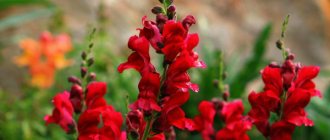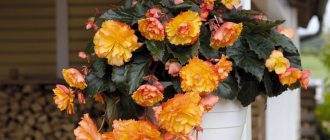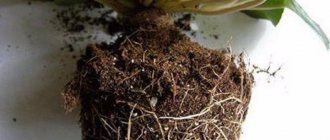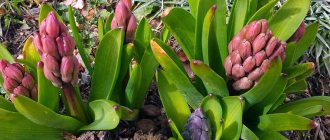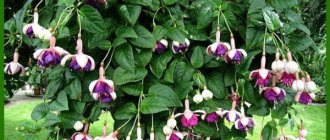This flower belongs to the plantain family; in total there are more than 50 species of antirrhinum (or snapdragon). Among them there are climbing and erect species. They are most often found in warm regions, but most varieties of antirrinum grow in North America.
Snapdragon belongs to the plantain family.
This flowering perennial has many names: dogs, biting dragon, cleft mouth, mouth. And all of them were given to the plant because flowers grow in inflorescences that look like an opening mouth.
This flowering plant appeared in flower beds at least 5 centuries ago , and breeders began to develop new varieties of snapdragon almost two centuries ago. Since then, a large number of new varieties of snapdragon have appeared - more than 1000. And Antirrinum major was taken as the basis for the development of all these varieties.
What does the snapdragon flower look like?
Snapdragons are erect subshrubs or herbaceous perennials. Their shoots are straight, tall (from 0.15 m to 1.0 m), strong, well branched, finely grooved green in color. The shoots form pyramidal bushes. The upper foliage is alternate, the lower foliage is opposite. Its shape is oval, slightly elongated, its color varies from light emerald to dark, the veins are light red.
The flowers are medium in size, irregular in shape, and have two lips. Varieties have been bred with simple and double flowers, which are collected in spike-shaped inflorescences. Their colors are white, yellow, pink, light fawn, and all shades of red are also found. But breeders have developed new varieties with two- or three-color flowers.
We also recommend reading:
16 most popular indoor plants Physalis: description of species and varieties, technology for growing from seeds Spruce in landscape design: the best ornamental varieties and characteristics of cultivation Kalanchoe: description of types and characteristics of care at home
The fruit is a capsule consisting of two nests, which contains a large number of small seeds (one gram can contain up to 1000 pieces).
The flowering of this herbaceous plant begins in the first ten days of June and ends with the onset of cold weather.
Flowering of snapdragon begins in the first ten days of June and ends with the onset of cold weather
How to care?
Growing this beautiful flower does not require complex manipulations. Cultivation technology includes the simplest procedures: watering, fertilizing, removing wilted shoots, and protection from pests. Thorough and regular loosening of the soil and mulching the soil to prevent weeds and drying out help to grow healthy plants.
Tall varieties that require special attention are used for cutting. You need to immediately grow hanging varieties in special hanging containers
Dwarf forms can be grown in containers and used to decorate terraces and balconies.
Watering
Snapdragons rarely need it. An adult plant needs additional moisture only during periods of drought. Watering in this case is carried out in the evening.
It is worth paying attention to the fact that after adding moisture, the soil must be thoroughly loosened and free from weeds.
Top dressing
The first fertilizing of the soil is carried out immediately before planting the snapdragon. In the future, fertilizers should be applied according to the following scheme:
- after rooting, organic matter and nitroammophoska are added;
- during the period of bud formation, a mixture of superphosphate, urea, and potassium sulfate (25 g per 10 l) is used.
Care during and after flowering
The main care for snapdragons during flowering is to remove the shoots on which the seed pods develop. If this is not done, the flowering period will be significantly shortened. When cutting, you need to remove the arrow under the lowest flower. Then the plant will produce new shoots and flower panicles.
The flowering period of snapdragon lasts quite a long time, until the onset of autumn frosts. If the plant is planted as a perennial, in October it is cut off almost at the root, leaving no more than 5-8 cm of length above the ground. The shoots remaining above the surface are covered with peat mixed with sawdust and covered with dry leaves.
Throughout the entire flowering period, annual snapdragon needs to remove faded buds and inflorescences to prevent self-seeding. As soon as all the flowers on the arrow have faded, it must be completely cut off. In autumn, the remains of the plant are dug up and burned, the soil is dug up to the depth of a spade bayonet.
Types and varieties of snapdragon
There are several types of classifications of this garden flower. The most common of them is based on plant height. There are the following groups of snapdragons:
- high (used for cutting) – above 0.7 m;
- universal (medium height) – 0.4-0.6 m;
- low – 0.25-0.4 m;
- dwarf - 0.15-0.2 m.
Among the tall species, the most popular are the following new varieties: F1 Red XL, F1 Pink XL. The shape of these bushes is narrow pyramidal, and the inflorescences are rich and bright in color. But older varieties are also popular among gardeners:
- Alaska - blooms in mid-summer, flowers are white with a green tint;
- Canary - with yellow buds;
- Anna German – soft pink;
- Ruby;
- Pink, etc.
Growing and care
Snapdragon is quite easy to grow, although it has certain requirements; growing seedlings yourself can be a little troublesome. The advantages include the fact that the plant tolerates autumn cold well and blooms until October.
Pruning, watering
To improve flowering, the ends of the shoots of young plants should be trimmed. Faded inflorescences must be trimmed regularly so that the antirrhinum begins to bloom again. But after pruning it will not produce seeds, and we will not be able to collect them next year.
Antirrinum requires watering throughout the flowering period. Water only when the substrate is dry and the plants show symptoms of wilting. When watering, avoid soaking the leaves.
Fertilizer
Before planting in the greenhouse, it is recommended to add approximately 1.5 kg of azophosphate and 0.5 kg of triple superphosphate per 1 m³ of prepared substrate. The optimal level of mineral elements for the growth and flowering of antirrinum, expressed in mg/l of substrate, is:
- N = 100-150,
- P = 100-200,
- K = 350-500.
Peat is added to the substrate in small quantities, as it constantly maintains high humidity around the roots, which is unfavorable for these plants.
At the beginning of summer, antirrinum should be fed 2-3 times with mineral or organo-mineral fertilizers, preferably 2-3 weeks before flowering. Annual plants can be fertilized throughout the growing season, even in August.
During the formation of flower buds, antirrhinum is fed with a 0.2% solution of mineral fertilizers with a predominance of potassium.
Fertilizing plants with nitrogen and too much salinity in the substrate is dangerous. When flower buds become visible, fertilizing should be stopped.
Wintering
In the southern regions, this perennial plant can survive the winter if dug in. This was discovered by accident when the antirrinum was buried for the winter along with roses growing nearby.
Wintering conditions:
- For wintering, the perennial variety must have woody shoots. It is enough that the main shoot and, possibly, side shoots are woody near the ground. Green shoots have no chance of surviving frosts in winter, even under a huge mound of earth.
- Height of the earth embankment. The mound must be large enough to cover the entire plant. Non-lignified shoots may protrude; in any case, they will freeze.
- If the plant is tall, you can tilt it, lay it on the ground and then build a mound.
- It is better to protect the plant from frost with regular soil. Before covering with soil, you can cover the plant with a piece of agrotextile. This is not done to keep the plant warmer, but to make it easier to remove soil in the spring.
- The period of shelter is like that of roses - at the turn of October - November.
- Removing cover - like roses - when forsythia blooms. Dead shoots should be cut off. The overwintered plant blooms very well in April.
The disadvantage of wintering is the “ruffled” shape, but this can be corrected by pruning.
The shoots of perennial antirrinum are the thickness of a pencil.
Features of ampelous snapdragon
The ampelous snapdragon was created by breeders specifically to grow these flowers in pots. Due to the fact that such varieties are too tender and do not tolerate low temperatures, ampelous varieties cannot be grown in open ground in the Moscow region and other regions with similar climatic conditions.
These varieties have stems hanging down, up to 0.8-1.0 m in size, and their buds are collected in racemose inflorescences. They bloom from the third decade of June until frost. The most popular variety is the hanging “Lampion”, the length of the stems can reach 0.8-1.0 m.
The ampelous snapdragon was created by breeders specifically to grow these flowers in pots
Varieties of ampelous flower shape
All modern types of hanging plants were bred by breeders from one species - Antirrhinum major. Varieties of snapdragon vary:
- size of flowers;
- the length of the hanging shoots;
- coloring.
If different species grow in very close proximity, they are cross-pollinated and the purity of the variety is lost. To choose the appropriate variety, let’s read the description and photo of snapdragon.
The first on the list will be snapdragon Candy Showers.
The plant has branches 25-30 cm long and a very large range of colors. The stems are flexible but strong. The inflorescences have a pleasant aroma and look like bright flower balls. It blooms very profusely and for a long time, even with short daylight hours, which is considered a feature of the species. This is the first variety of ampelous antirrinums, which began to be propagated by seeds. Snapdragon ampelous “Lampion”
It is distinguished by long branches that can reach 1 meter. The average length of one shoot ranges from 50 cm to 70 cm. This is a hybrid variety, quite rare and very beautiful. It blooms all summer, forms bright drooping shoots. Grown in hanging baskets and flowerpots. Gardeners compare the variety to a lush flower beard.
Snapdragon ampel “Amulet”
characterized by uniform growth and relatively short shoots. The length of the branches is about 20 cm. The flowers on the plant have a variety of colors. Distinctive characteristics of the variety:
- cold resistance;
- lush flowering in partial shade;
- need for regular feeding.
Variety of ampelous antirrinum "Magic"
has branches of medium size - 50 cm. The plant is large and has an interesting spherical shape. It reaches 60 cm in diameter. It produces small, glossy flowers, but in large quantities. It requires lighting, so it is recommended to place the pots in sunny places. Growing seedlings of ampelous varieties
Growing ampelous varieties of snapdragon from seeds has its own nuances, but is quite accessible even to beginning flower growers. Gardeners who decide to grow ampelous varieties of antirrinum on their own purchase them in specialized stores. According to reviews from summer residents, a bag contains no more than 10 small snapdragon seeds of the ampelous variety, so it is better to buy 2-3 bags at once. Taking into account the natural losses when growing seedlings, this number of seeds will be the most optimal.
Pre-sowing treatment of ampel seeds is carried out by the manufacturer, so steps such as soaking or disinfection can be safely skipped. When the seeds are purchased, it is necessary to determine the timing of when to plant snapdragon seedlings. The best time for sowing ampelous varieties is considered to be the second half of March - early April. In Siberia – mid-March.
For tender ampel seedlings, it is necessary to prepare containers. It is convenient to grow seedlings in peat tablets, but for antirrinum it is better to prepare a suitable soil mixture.
Plants prefer medium-loose fertile soil with a light structure
This is important because the seeds of snapdragon varieties are very small and easily fall deep. The main thing is that the soil is slightly alkaline or neutral and nutritious.
Flower growers prepare a peat mixture, add a little sand and turf soil. At the same time, you should not get carried away with the amount of humus. You need very little of it so that the soil does not turn out “rotten”. Some people prefer to purchase ready-made soil for flower seedlings.
A day before the scheduled date of sowing the ampel seeds, the soil is treated with a solution of potassium permanganate to prevent infection of the seedlings by the “black leg”.
Seedlings at the beginning of growth are very small and tender, so you should not take 0.5 liter cups. You need to sow seeds of ampelous antirrinum varieties in small containers, and then gradually increase the volume.
The container is washed with a disinfectant, dried and filled with soil. Level the surface and moisten with a spray bottle.
Now the seeds of ampelous varieties of snapdragon are placed on the surface of the soil.
The seed coat is destroyed to release future shoots. This applies to granules containing planting material.
When all the seeds of the ampelous antirrinum varieties are laid out, the container is covered with film. Provide the necessary parameters - air temperature 24°C-25°C and good lighting. If all conditions are met, the first shoots can be seen after a week and a half.
Video on how to properly sow seeds of ampelous antirrinum varieties:
Technology for growing snapdragons from seeds at home
In nature, snapdragon is a perennial plant, but in garden plots it is often grown as an annual. Therefore, flower growers who grow these flowers in the Volga region, the middle zone, the Urals and Siberia, have to first grow seedlings from seeds at home. How to do it right?
This process is not too labor-intensive, so even a beginner can handle it. Seeds for seedlings should be sown in the first ten days of March in containers with a diameter of about 11-12 cm. These containers must have drainage holes. The soil mixture that is poured into the bowls consists of several layers: coarse river sand is poured onto the bottom, and the next layer consists of compost mixed with sand. The soil should be compacted, leveled and slightly moistened. Since snapdragon seeds are too small, they are mixed with sand and evenly distributed over the surface of the soil in bowls. The top of each container is covered with polyethylene, which is lifted for a while every day to ventilate the crops. Spraying of moisture should be carried out as the soil dries. The air temperature in the room should be maintained within +22+23⸰С.
The first seedlings appear in 10-14 days
Usually the first seedlings appear after 10-14 days. After this, the containers with seedlings are placed in a bright place, and when most of the seeds have sprouted, it is necessary to remove the polyethylene.
At first, snapdragon seedlings grow slowly, but don’t worry - they will have time to grow enough by the time they are planted in open ground. It is necessary to create the necessary conditions for its growth - the air temperature should be about 20⸰C, and also do not forget about regular watering of the seedlings. However, seedlings should not be overwatered, otherwise young plants may become infected with a fungal disease such as blackleg.
Diseased plants are carefully removed with tweezers, and the place where they grew is disinfected with charcoal.
Diseases and pests
If you do not follow the growing rules, the seedlings may be affected by blackleg.
This is a dangerous fungal disease that appears with the following indicators:
- high humidity;
- sudden temperature changes;
- acidified soil;
- thickened crops;
- lack of nitrogen fertilizers.
A sign of the disease is the appearance of a dark rim above the root collar of the plant.
The diseased plant is removed from the seedling box, and the soil is spilled with boiling water or a weak solution of potassium permanganate.
To protect seedlings from blackleg, you need to adhere to the following rules:
- Double treatment of the soil in seedling boxes: copper sulfate, boiling water or bleach.
- When growing seedlings, observe the temperature and humidity conditions.
- Carry out regular watering and ventilation.
- Do not thicken the plantings and pick grown seedlings.
Planting snapdragons in open ground
Grown antirrinum seedlings are planted in open ground in the third ten days of May - the first ten days of June. Planting and further caring for these flowering plants are also not very complicated procedures. And if all the rules for planting seedlings and further care are followed, then the flowers will soon delight their owners with abundant and long-lasting flowering.
Selection and preparation of a landing site
First of all, you should choose a suitable corner in the garden for these lovely flowers. It can be sunny or slightly shaded, but without stagnant moisture in the soil and protected from gusts of cold wind. And the soil should be light and nutritious.
Usually sand, compost and high-moor peat are added in equal proportions to the flower beds where these plants will grow and bloom. Optimal soil acidity is neutral or slightly alkaline (pH 6-8).
The soil for snapdragons should be light and nutritious.
Technology and timing of planting snapdragons
The distance between snapdragon seedlings in a row depends on the height of these flowers . Between tall varieties you need to leave a space of at least 0.45 m, between medium-sized ones - 0.3 m, between low-growing ones - 0.2 m, between dwarf ones - 0.15 m.
As soon as the seedlings take root in a new place, they quickly grow and within two to three weeks the young plants become beautiful flowering bushes.
Seedlings should be planted in well-watered beds.
Planting seedlings
There is an opinion that Snapdragon can be planted directly in open ground. Of course, it’s possible, but flowering will occur a couple of months later, and this is already the end of summer. And in the fall, frosts may occur, so in order to enjoy the modest beauty of this flower, it is better to plant it through seedlings. And for this you need to prepare containers, soil and, of course, the seeds themselves.
Preparing soil and containers
Snapdragon is not picky about soil. Any fertile soil will do. You can buy universal soil for flowering plants at the store, or you can prepare the soil for seedlings yourself. To do this take:
- Garden soil - 3 parts;
- Garden soil - 3 parts;
- Peat – 3 parts;
- Sand – 1 part.
Snapdragon loves the ground near coniferous trees. Therefore, it is useful to add such soil to the composition of the prepared soil.
Before sowing, the soil must be disinfected. Heat it in the oven or pour boiling water over it. Then you can treat it with a weak solution of manganese.
Plastic containers, disposable cups or special boxes for seedlings are suitable as containers. The height of the container must be at least 10 cm. They must also be washed with hot water and treated with a solution of potassium permanganate.
It is very convenient to sow snapdragon seeds in peat tablets. Before use, the tablets must be soaked in a small amount of water to swell.
Selection of seeds and preparation for sowing
Before sowing seeds, you need to decide whether you want to get a tall or small plant. Use flowers for cutting or admire them in compositions created in the garden. Based on this, you need to choose a flower variety.
Before sowing, seeds must be treated in a weak solution of manganese and soaked for several minutes in a growth stimulator. This will help you get healthy and strong seedlings.
Sowing
Drainage is poured into the bottom of the prepared container; it can be small pebbles or coarse sand. Then the prepared soil is placed. Make shallow furrows in the soil every 3-4 cm, and lightly moisten the soil with a spray bottle. The seeds are mixed with sifted sand and sown in the furrows. Sprinkle a thin layer of sand on top and moisten again.
Cover the container with film or glass and put it in a warm place. The temperature should be at least 18-20 degrees Celsius. All that remains is to wait for the shoots to appear. They will appear in about a week and a half. If the soil dries out during this time, it is moistened. The plantings must be ventilated every day by raising the shelter for a few minutes.
Features of snapdragon care
Antirrinum is one of the most unpretentious garden flowers. The main measures for caring for these plants are:
- watering;
- loosening the soil;
- weed removal;
- fertilization;
- removal of faded flower stalks.
Tall varieties should be tied to supports so that gusts of wind or heavy rain do not break off the blooming inflorescences. To achieve abundant flowering from these garden flowers throughout the season, it is necessary to pick off the drying inflorescences, not allowing the seeds to ripen. Therefore, the old shoots are cut off along with the dried flowers; in this case, new shoots with flowers quickly appear on the bush.
How to properly care?
Chandelier balsam is a moisture-loving crop. It is distinguished by juicy and moisture-filled stems. If there is a lack of water, the flower will not disappear, but will lose its elasticity and drop its lower leaves. In summer, provide abundant watering. The soil should always be moist. In winter, reduce moisture, preventing the earthen clod from drying out. Stagnation of liquid in the pan is harmful, as it is fraught with rotting of the roots and stems.
It is necessary to fertilize every 2 weeks, starting from April and ending in August. Mineral fertilizers intended for flowering plants are excellent for this. Make sure that nitrogen fertilizers are not in excess, as this will lead to rapid growth of stems and inhibit the formation of flowers.
The plant responds positively to Kemira. This is a fertilizer that contains the following components:
State of rest
At the end of flowering, cut off the flower stalks and place the plant in a cool place where the temperature exceeds +15 degrees. At the same time, water the balsam sparingly. When new shoots form in February, place the flower in a room with a higher temperature and water more often.
Common diseases and pests
In winter, ampelous balsam is exposed to fungal diseases, especially gray rot.
To eliminate this problem, you need to clean the roots of the plant from the old soil and replant it in a new container with soil. If the humidity in the room is low, this is fraught with an attack by spider mites. This can be determined by the curled leaves. They fall off over time. The following drugs will help eliminate spider mites: Actellik, Neoron.
The plant can be infested with whitefly, which causes the leaves to turn yellow. Insects settle on the inside of the lower leaves. Fufaron and Decis are used for treatment.
Rules for combining snapdragons with other plants in the flowerbed
When perennial plants just begin to grow in flower beds, these annual flowers perfectly fill empty spaces, perfectly complementing the overall appearance with their abundant flowering.
Since there are a large number of antirrinum varieties of different heights and colors, you can always choose the necessary varieties for a specific flower garden, border, or simply fill an empty space on the lawn.
Snapdragon is one of the many garden flowers that is widely used in landscape design in the design of park areas, planted along paths and borders, in the design of ribbon flower beds and round flower beds. These flowers are also popular among summer residents in the garden, as they combine well with most other garden flowers.
Sowing seeds for seedlings step by step
Table. Instructions for growing snapdragons in seedlings.
Steps, photo
Description of actions
For antirrinum seedlings, a universal soil mixture is suitable, which can be purchased at a specialized store. So that the small seeds of the plant can hatch, the soil is sifted and washed sand is mixed into it. The mixture can also be prepared from soil, peat and sand, mixing them in a ratio of 1: 2: 0.5. To protect seedlings from diseases and weeds, it is recommended to steam the soil mixture using a steamer. Steaming for 1 hour will protect the plant from blackleg. In order to make the soil slightly alkaline, after steaming it is necessary to add half a tablespoon of dolomite flour or 1 tablespoon of ash per 0.5 kg of soil. The soil mixture needs to be slightly moistened.
Fill the container with the soil mixture, level the surface and tamp it down quite a bit.
Place the seeds on the fold of a piece of paper and carefully spread over the entire surface. Sprinkle soil on top with a layer of no more than 1 cm.
Use a spray bottle to spray the top layer of soil with water.
In this case, some seeds may float to the surface. This is not a problem, since they need more light to germinate.
Cover the container with a transparent lid or plastic bag. Then install it in a lighted place. For seedlings to emerge, it is necessary to maintain a room temperature of +21-24°C. The soil must be periodically irrigated with water, otherwise the seeds will dry out and not germinate.
In about a week, the shoots will begin to hatch. After emergence, it is recommended to maintain a temperature of +16+29°C. At first, the seedlings grow at a slow pace. At this time, it is especially important to avoid excess water. Watering should be done so that moisture does not fall on the leaves. Frequent ventilation is required. The container lid must be removed after 7 days. Immediately after this, the plants must be protected from direct sunlight.
If the seedlings are too dense, thin them out using tweezers.
Picking is done after the first two true leaves grow. Snapdragon is not afraid of this procedure. In the new place he will feel good almost immediately. The same soil mixture is suitable, but without preliminary sifting and steam treatment. Fill cups or pots with soil and lightly compact the soil. Then you need to make holes so that there is enough space for the roots. Deepen the sprout by 3 mm and sprinkle with soil. Lightly compact the soil, otherwise the sprout may tilt when wet.
After picking, the seedlings must be carefully watered. In this case, it is advisable to hold the sprouts until the moisture is completely absorbed.
It is recommended to apply liquid fertilizer to the soil once every 14 days. Grown seedlings can be pinched between the fourth and fifth pairs of leaves to improve growth and further lush flowering.
In the second decade of May, you can plan to transfer the seedlings to open ground. Snapdragons require a well-lit place. In shady areas, antirrinum will not bloom so profusely. If the seedlings have been hardened, then they are not afraid of even slight frosts. The soil must be loose for good plant growth. Fertile, slightly alkaline soil is suitable (otherwise the roots will not be developed enough). Heavy soil must be diluted with sand, dolomite flour or ash. Before planting seedlings, mineral fertilizer should be added to the soil, including phosphorus, potassium and nitrogen.
Holes for planting must be dug at a distance of up to 45 cm from each other, depending on the height of the future plant. The specified distance between plants must be maintained if a tall variety is planted. For medium-sized antirrinums, this interval is 30 cm. And plants of small varieties of snapdragons will get along well at a distance of 20 cm between them.
Planting must be completed with generous watering, after which it is necessary to cover the soil with a layer of peat.

